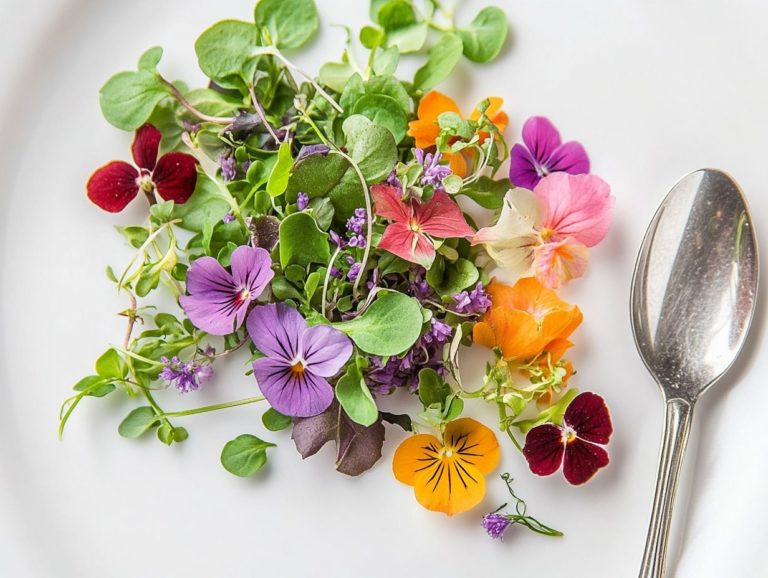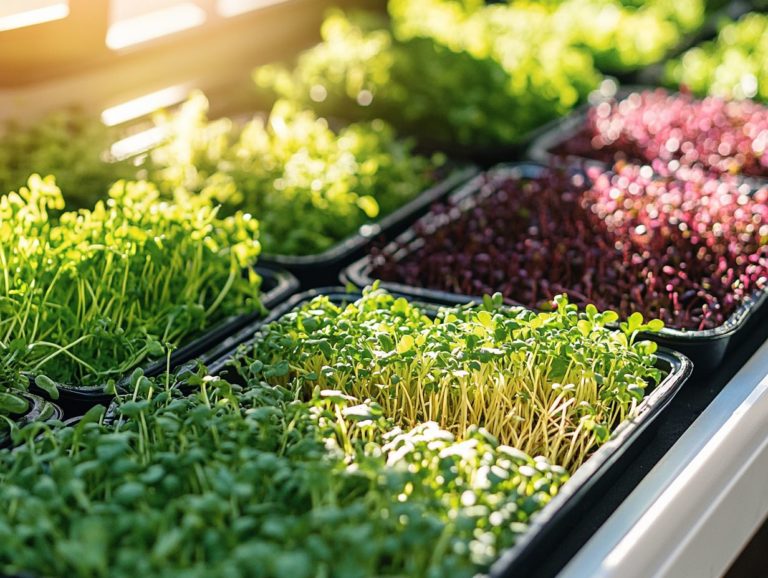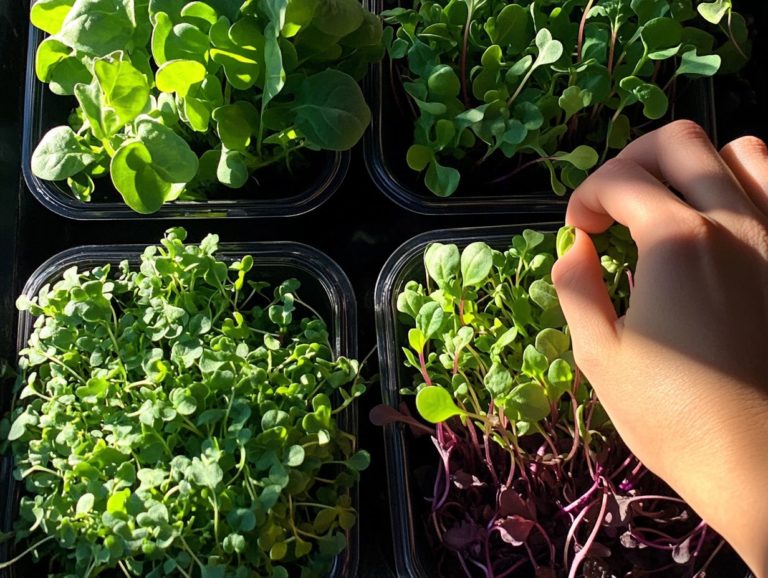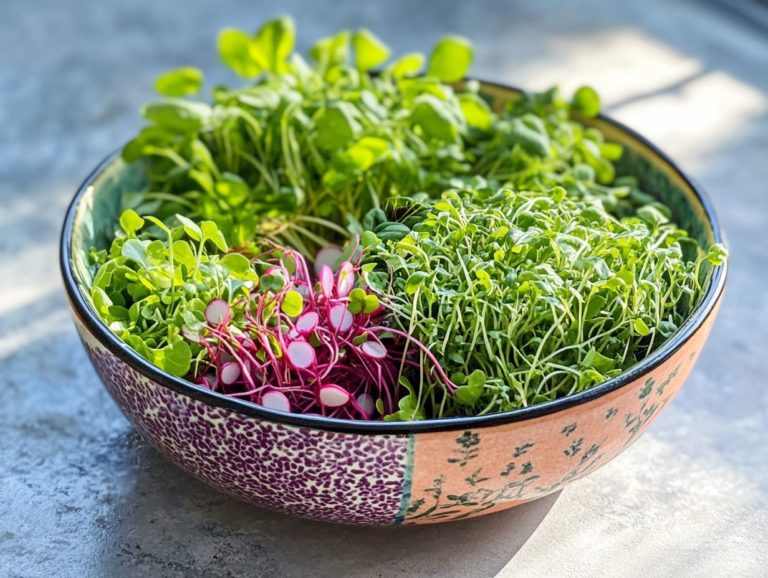Exploring Microgreen Varieties for Sustainable Eating
Microgreens are petite, nutrient-dense plants that have captured the attention of culinary enthusiasts. These vibrant greens do more than just elevate the flavor and texture of your dishes; they pack a punch of health benefits as well, thanks to their impressive nutritional properties. Don t miss out on the incredible health benefits of microgreens! Let s dive into their vibrant world!
This article delves into the diverse types of microgreens and their impressive nutritional profiles. It also guides you through the rewarding process of cultivating your own edible plants at home.
Furthermore, you’ll learn about their significant role in sustainable eating and how they contribute to reducing food waste while promoting agrobiodiversity.
Discover inventive ways to weave these delightful greens into your meals, adding a fresh twist to your culinary creations. Elevate your diet while being mindful of the planet and embrace the health benefits they offer!
Contents
- Key Takeaways:
- What are Microgreens?
- Types of Microgreens
- Growing Your Own Microgreens
- Sustainable Eating with Microgreens
- Incorporating Microgreens into Your Meals
- Frequently Asked Questions
- What are microgreens and why are they considered sustainable for consumption?
- How do microgreens benefit our health and nutrition?
- What types of microgreens can I find for sustainable eating?
- How can I use microgreens in my meals?
- What should I consider when growing microgreens?
- How can I support sustainable eating by choosing microgreens?
Key Takeaways:
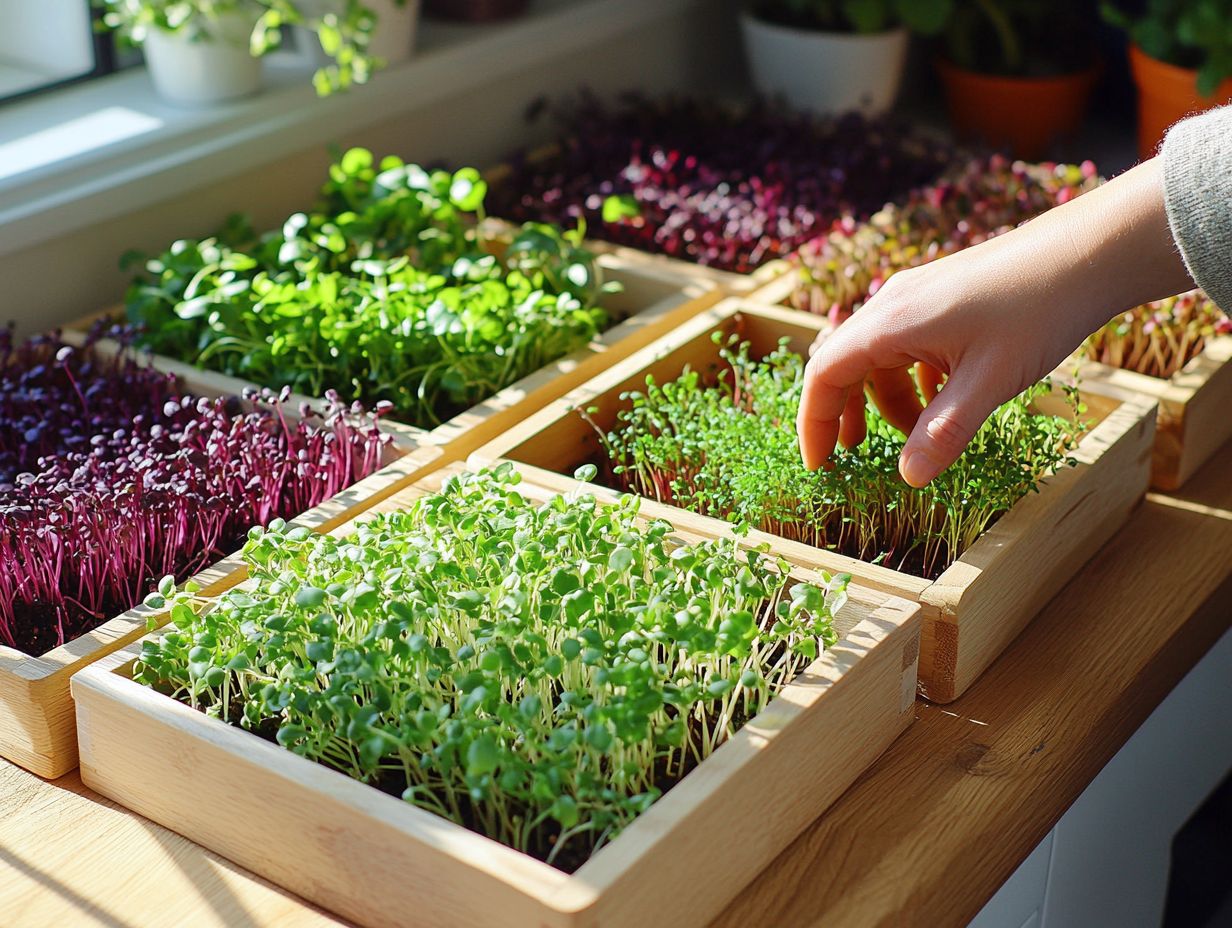
- Microgreens are tiny plants that are packed with nutrients and can easily be grown at home, which makes them a fantastic choice for anyone looking to eat healthier. Their nutritional properties make them a superfood choice.
- By incorporating microgreens into your meals, you can reduce food waste and contribute to a more environmentally friendly way of eating, showcasing their vibrant colors.
- There are many types of microgreens with varying nutritional benefits, including their fiber content and antioxidants. They can be used in creative and delicious ways in recipes to enhance the flavor profiles and nutrition of your meals.
What are Microgreens?
Microgreens are the young seedlings of edible plants that you can harvest just after the cotyledon leaves have developed, but before the true leaves make their appearance, ensuring optimal seed density for growth. These petite greens, which include a variety of vegetables like Broccoli, Kale, and Arugula from the Brassicaceae family, are not just visually striking; they re also celebrated for their remarkable nutritional benefits, often earning the title of superfood, thanks to their immune-boosting capabilities.
Packed with flavor and nutrients, microgreens can transform any dish into a delicious delight, making them a must-have in health-conscious diets that focus on fresh greens and flavor profiles.
Benefits of Incorporating Microgreens into Your Diet
Incorporating microgreens into your diet presents a wealth of health benefits, including increased fiber content and antioxidants, making them a superb choice for anyone eager to elevate their nutritional intake.
Research shows that even in modest servings, these vibrant greens provide a rich source of essential vitamins and minerals, making them a sustainable option for those committed to a healthy eating plan, particularly when considering quick shipping from seed companies.
When integrated into a diet that aligns with nutritional guidelines, microgreens can serve as formidable allies in preventing chronic illnesses and enhancing food security. Various cooking methods like steaming or lightly sautéing can both preserve and amplify their nutrient bioavailability and contribute to the culinary delight of any dish, offering a delightful way to incorporate them into your meals while ensuring optimal health benefits. Additionally, you can explore growing microgreen varieties in small spaces and conduct a germination test to help you identify the most nutrient-packed varieties, enabling you to make informed choices in your pursuit of a sustainable diet.
Types of Microgreens
Microgreens present an exquisite array of types, each boasting unique flavors and nutritional profiles, including various microgreen varieties tailored to elevate your culinary creations. Among the most popular varieties are Broccoli, Kale, Arugula, and Mustard, all members of the Brassicaceae family, highlighting the importance of seed density for growing conditions.
Each offers its own distinct taste, coupled with remarkable health benefits that cater to your discerning palate and wellness goals.
Common Varieties and Their Nutritional Value
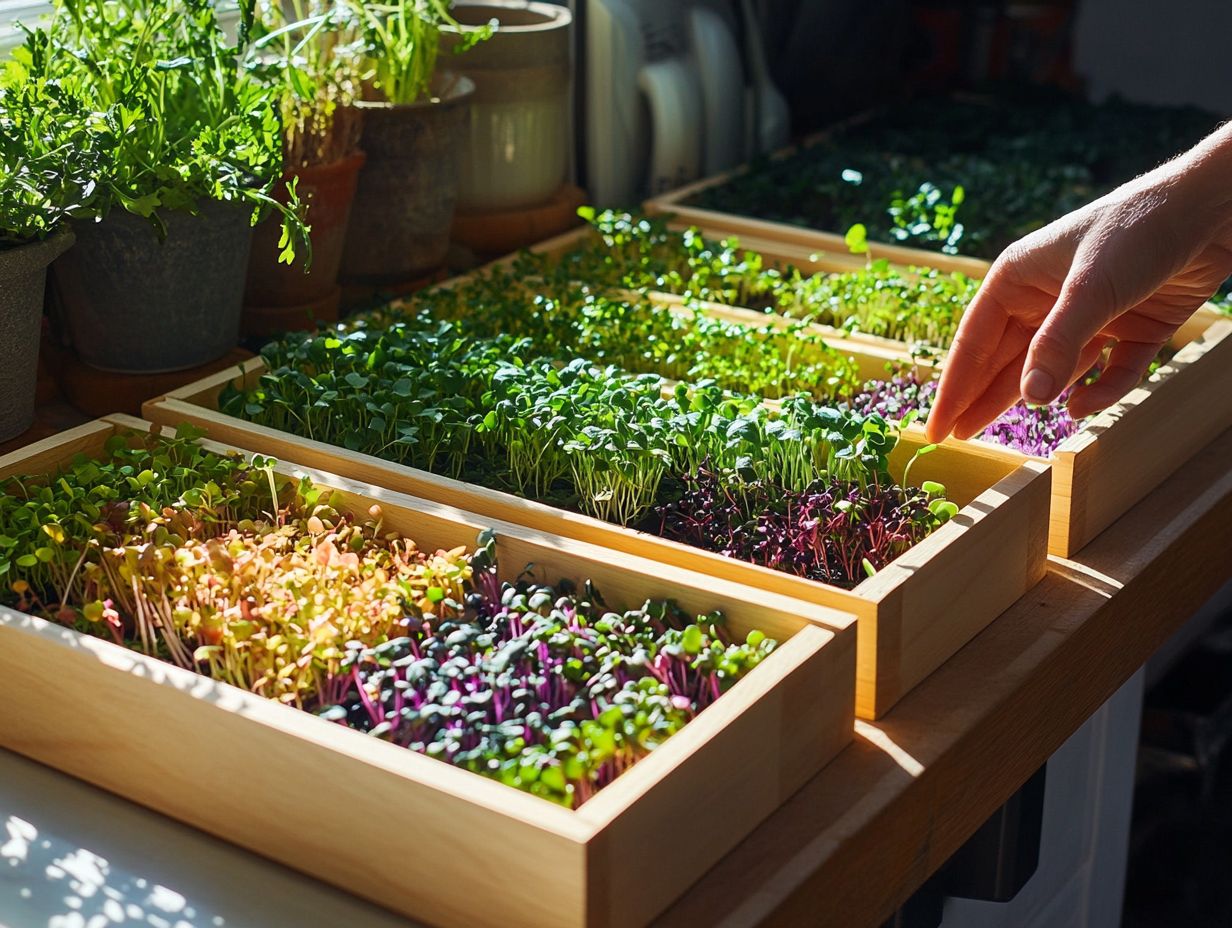
Common microgreens like Broccoli, Kale, Radish, Spinach, and Cilantro are not just flavorful additions to your meals; they also bring impressive nutritional benefits. Each variety offers unique advantages, from high fiber content to antioxidants and essential vitamins. They are often referred to as baby greens due to their size.
Take Broccoli microgreens, for example. They’re rich in sulforaphane, a natural compound found in broccoli that may help fight cancer. Kale microgreens, on the other hand, are a powerhouse of vitamins A, C, and K, contributing to your overall health.
Spinach microgreens stand out with their high iron and folate content, making them an excellent choice for salads or sandwiches. They offer a vibrant addition to any meal. Let’s not forget about Radish microgreens, which add a delightful peppery kick while packing in vitamin C to enhance both nutrition and flavor. For culinary professionals looking to expand their knowledge, exploring microgreen varieties can be incredibly beneficial.
Incorporating these aromatic herbs into your everyday cooking methods whether you saut them, blend them into smoothies, or creatively sprinkle them over dishes will amplify your health benefits. They also support sustainable practices and enhance the overall gardening experience. To learn more about cultivating these nutritious plants, check out our guide on how to grow your favorite microgreen varieties. Microgreens require significantly less water and space compared to traditional farming, making them a smart choice for both your plate and the planet.
Growing Your Own Microgreens
Imagine growing your own microgreens! It s a rewarding adventure that lets you savor fresh, nutrient-dense greens right at home. By creating the ideal growing conditions think the right amount of seeds, high-quality seeds, and suitable microgreens kits you can effortlessly cultivate a variety of delightful microgreens like Kale, Basil, and Arugula.
Supplies and Steps for Growing Microgreens at Home
To successfully grow microgreens at home, gather quality supplies, including high-quality seeds, growing trays, and a suitable growing medium for optimal germination. Pay attention to proper seed density and conduct regular germination tests to ensure a successful yield.
Along with these essentials, have a spray bottle for easy watering and a lightweight cover to maintain humidity during the sprouting phase. Once you ve assembled your supplies, fill your trays with the growing medium, spread the seeds evenly, and lightly press them down. Water gently to avoid displacing the seeds, and keep them in a warm, dark place until they sprout.
As they begin to grow, move them to a well-lit area and continue watering regularly just be careful not to oversaturate. Food safety is key; ensure your trays are clean and your hands are washed before handling.
Don t forget to join local microgreens communities today! Share tips and enjoy the benefits of sustainable gardening with fellow enthusiasts. This experience not only elevates your meals but also positively impacts the environment.
Sustainable Eating with Microgreens
Adopting a sustainable diet is becoming essential in today s world. Integrating microgreens into your meals can significantly reduce food waste while promoting agrobiodiversity.
These petite powerhouses not only provide a wealth of health benefits but also boast a minimal environmental impact. They are an outstanding choice for those who prioritize eco-conscious eating and sustainable practices.
How Microgreens Can Help Reduce Food Waste

Microgreens can play an important part in your quest to reduce food waste by allowing you to utilize every part of the plant. This ensures a sustainable diet while enjoying their culinary uses.
By incorporating these seasonal microgreen varieties into your meals, you can maximize your use of available produce while embracing a sustainable diet that supports health-conscious cooking.
Consider the flavorful tops of beet and radish microgreens; they can transform your soups into culinary masterpieces with their vibrant garnish, showcasing their role in enhancing flavor profiles. Meanwhile, their stems are perfect for chopping into stir-fries or blending into smoothies, elevating the overall delight of your dishes while ensuring high food safety standards. For more information on different types, check out this quick guide to common microgreen varieties.
These tiny greens not only bring depth and color to your plate but also enhance flavor profiles in surprisingly unique ways, maximizing their culinary uses. By exploring cooking methods that showcase these plants, such as tossing them into must-try microgreen varieties for salads or using them as fresh toppings for pizzas, you can significantly minimize waste and boost your meals’ nutritional value.
Their impressive health benefits make them an irresistible choice for the health-conscious cook, especially when used in a sustainable diet!
Environmental Benefits of Microgreens
The environmental benefits of growing and consuming microgreens are truly remarkable. They offer everything from enhanced food security to the promotion of agrobiodiversity, which refers to the variety of plants and animals in agriculture, making them a compelling choice.
These tiny edible plants require minimal space and resources, making them an exceptionally eco-friendly choice for your home gardening endeavors and contributing to their nutrient-packed growth.
Their nutrient-dense qualities mean that even a small harvest can deliver significant health benefits, extending beyond your personal wellness to positively impact local ecosystems and support food security.
Since microgreens thrive in compact growth conditions and are easily cultivated indoors, they help reduce the need for extensive agricultural land while minimizing the carbon footprints associated with food transport. For those interested in the different types, exploring microgreen varieties: taste and flavor guide can enhance your growing experience. This makes them a sustainable option!
Partnering with various seed companies can provide you with a diverse range of strains, encouraging a richer variety of fresh greens that support local biodiversity and enhance your health benefits. Ultimately, growing microgreens not only enhances your health but also contributes to nurturing a more resilient and sustainable environment. For those new to this endeavor, exploring microgreen varieties: a guide for beginners can showcase their environmental impact.
Incorporating Microgreens into Your Meals
Incorporating microgreens into your meals can truly elevate both the flavor and nutritional value of your dishes. These versatile greens offer an array of possibilities, enhancing your recipes with vibrant colors and distinctive flavor profiles.
Whether you’re adding them to salads, sandwiches, or entrees, microgreens transform every meal into a culinary delight, promoting a sustainable diet. Exploring the benefits of growing diverse microgreen varieties can enhance your culinary experience even further.
Creative and Delicious Ways to Use Microgreens in Recipes
Microgreens can be seamlessly woven into a variety of exquisite recipes, enhancing both flavor and visual appeal. Picture garnishing your soups, adding delightful crunch to salads, or infusing a burst of flavor into sandwiches these versatile greens unlock a world of culinary creativity!
Imagine the peppery zest of arugula microgreens brightening your simple avocado toast or the vibrant basil microgreens elevating a classic Caprese salad. Each variety offers a unique flavor profile that can elevate any dish.
For those keen on optimizing health benefits, incorporating kale microgreens into your smoothies not only provides a nutrient boost but also adds a subtle earthiness.
With quick shipping options available, even those with minimal gardening know-how can savor the fresh flavors and nutritional wealth of these tiny greens right in their own kitchen. By experimenting with different microgreens, you can transform everyday meals into gourmet delights, ensuring every dish is both nourishing and visually captivating. To get started, check out this guide on how to choose microgreen varieties for your garden.
Start incorporating microgreens into your meals today and discover the delicious and nutritious possibilities they offer!
Frequently Asked Questions
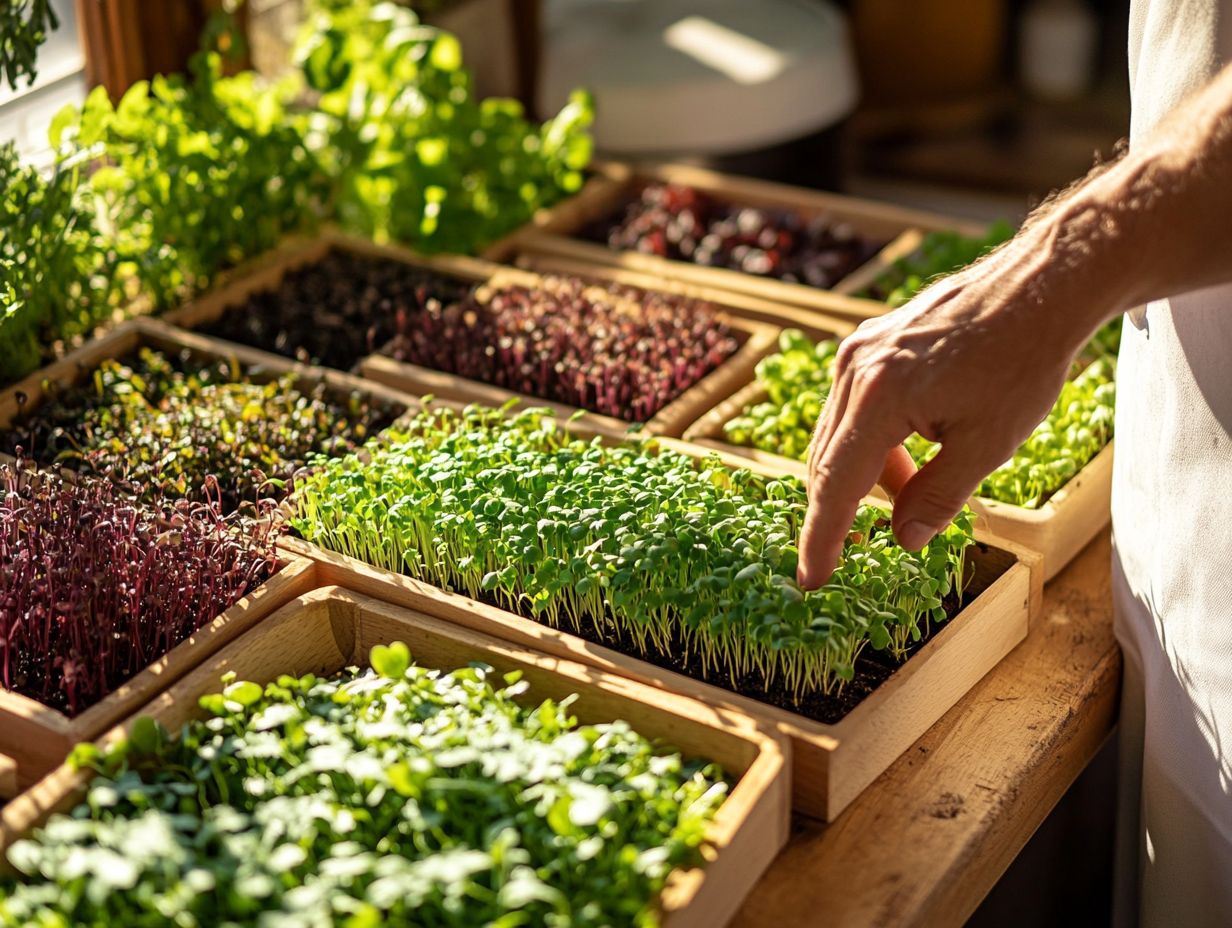
What are microgreens and why are they considered sustainable for consumption?
Microgreens are young, edible plants harvested after sprouting their first true leaves. They are sustainable because they grow quickly in small spaces, which uses less land and water.
How do microgreens benefit our health and nutrition?
Microgreens are nutrient powerhouses packed with vitamins, minerals, and antioxidants. They often contain more nutrients than mature plants, making them a fantastic addition to your diet.
What types of microgreens can I find for sustainable eating?
You can find various microgreens such as kale, arugula, radish, and broccoli. Each type brings unique flavors and versatility to your dishes.
How can I use microgreens in my meals?
Add microgreens as toppings on salads, sandwiches, or wraps. They also make great garnishes for soups, smoothies, and omelets. Try mixing different types to discover your favorite flavors!
What should I consider when growing microgreens?
Microgreens can thrive indoors or outdoors. They need proper light, water, and drainage. Always choose organic, non-GMO seeds, and wash them well before eating.
How can I support sustainable eating by choosing microgreens?
Choosing microgreens helps reduce your carbon footprint and supports local farmers. Look for microgreens grown with hydroponic or vertical farming methods; these techniques use less water and land than traditional farming.


